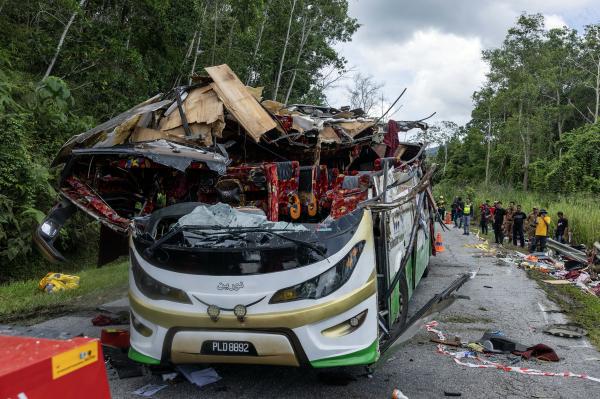PUTRAJAYA, July 18 — Excessive speed, which was more than twice the legal limit, was among the key factors behind the fatal bus crash that claimed the lives of 15 students of the Universiti Pendidikan Sultan Idris (UPSI) in Gerik, Perak, on June 9.
This was revealed in the preliminary report released today by the Transport Ministry's (MOT) Special Task Force.
It revealed that the dashcam footage and kinematic analysis showed the bus was travelling at over 117 kilometres per hour (km/h), which is almost double the posted speed limit of 60 km/h for that area.
"Based on the sequence of events captured in the dashcam footage and the physical evidence at the location, the bus skidded before overturning.
"This indicates that the bus speed during the incident exceeded the critical threshold for skidding and most likely also surpassed the critical speed for overturning," stated the report.
The bus overturned to the left before skidding and hitting a W-beam road barrier, which then penetrated the cabin and caused serious injuries and deaths among the passengers.
"Although the driver claimed that there was a brake system failure, the investigation has not yet confirmed any technical damage.
"Initial inspections have identified signs of possible overheating of the brake components, but this situation could also be caused by excessive or inappropriate use of the brakes. A detailed assessment is still being carried out and will be reported in the final report," it said.
It was also revealed that the bus was not equipped with any speed limit devices, like a Speed Limitation Device (SLD) or an active GPS tracker, which made it difficult to detect the actual speed at the time of the incident and thus limited the quantitative evidence for assessing driving performance.
Following the accident, the Road Transport Department (JPJ) announced the mandatory implementation of SLDs in stages, starting from October this year, depending on the category and date of registration of the relevant vehicles. This is to ensure that speed control can be implemented more effectively.
The report also revealed that the absence of seat belts for all passenger seats, except the driver's seat, is a severe weakness in terms of passive safety.
"The four front seats that should have been equipped with seat belts according to existing regulations were also not installed, reflecting non-compliance with minimum safety requirements.
“This situation raises questions about the thoroughness of the vehicle inspection process and technical approval during registration," it said.
The findings also showed that 11 of the 15 victims who died were seated on the left side of the bus, which is the main impact zone due to the collision with the road barrier, while another was sitting in the back row, which was also exposed to high impact forces.
"The absence of seat belts exposed passengers to internal impact and the risk of being thrown out of the vehicle.
"Although the seat anchorage system was not detached, the extremely high impact force caused the roof structure and main pillars to fail, and the road barrier penetrated the cabin. This situation limited the survival space and increased the risk of fatal injuries," stated the report.
The investigation also found that both bus drivers had a worrying record of traffic offences, with the first driver (who was driving at the time of the incident) having 18 traffic summonses from the Royal Malaysia Police (PDRM), with 13 of them still outstanding.
The majority of the summonses issued for the first driver were for speeding, and this high record of offences reflects a pattern of risky driving and repeated non-compliance with road laws.
As for the second driver, he had nine active summonses from the JPJ and 13 outstanding summonses from PDRM.
However, there is no evidence yet that the driver was driving under the influence of alcohol or drugs, as the official results of the toxicology test had not yet been received at the time of the report.
The investigation also revealed systemic weaknesses in the aspects of industry governance, regulatory compliance and the effectiveness of enforcement by the operator and regulatory agencies.
“Serious violations that were detected, which include unauthorised license rental, abuse of the tour guide exemption application system, and failure of safety audits, which demonstrate the inability of the current system to ensure safe and ethical operation of tourist vehicles," it said.
Three entities involved in the vehicle operation chain: Kenari Utara Travel and Tours, Noreen Maju Trading, and Nuratiqah Travel and Tours, underwent a safety audit (JISA) by JPJ between June 9 and June 11.
"The three companies were classified as non-compliant with very low audit scores (between 10 per cent and 12 per cent) and were found to have failed to comply with all mandatory requirements under the ICOP-Safety.
"Among the critical failures recorded were the absence of an occupational health and safety officer or coordinator, the absence of an active and functional GPS monitoring system, the absence of systematic records for monitoring driving time and rest periods, the absence of an eTmergency response plan (ERP), and the absence of an emergency line number on the vehicle," stated the report.
On June 9, the nation was shocked by a fatal accident involving a bus carrying 42 UPSI students who were travelling from Jertih, Terengganu, to Tanjung Malim, Perak.
The accident, which also involved a Perodua Alza multi-purpose vehicle (MPV), on the East-West Highway (JRTB) near Tasik Banding in Gerik, claimed the lives of 15 UPSI students.
— Bernama


